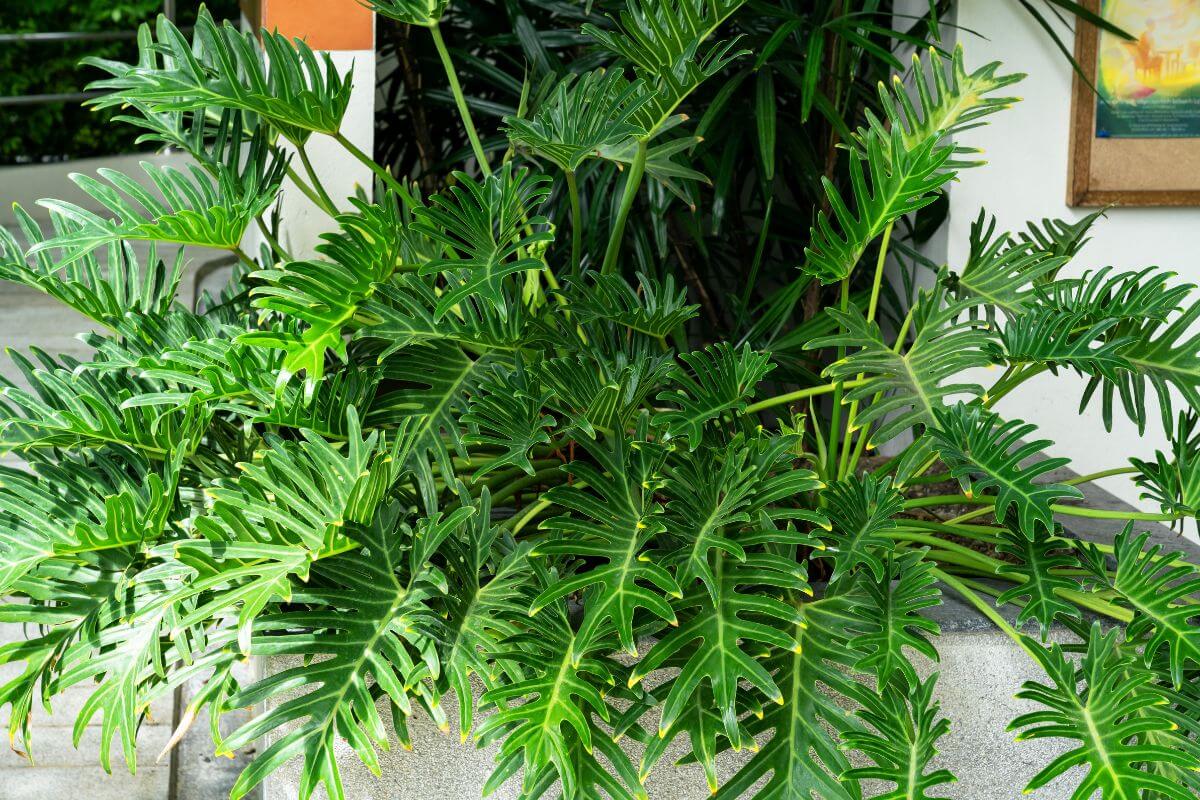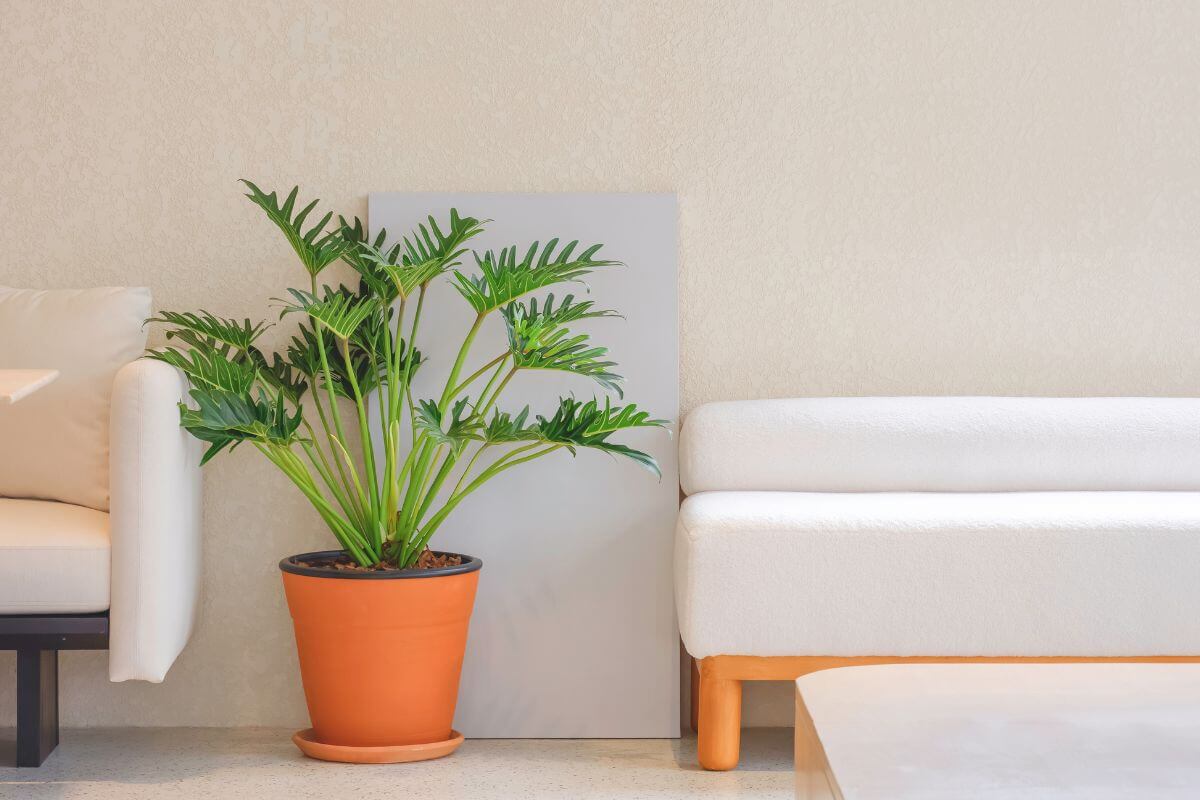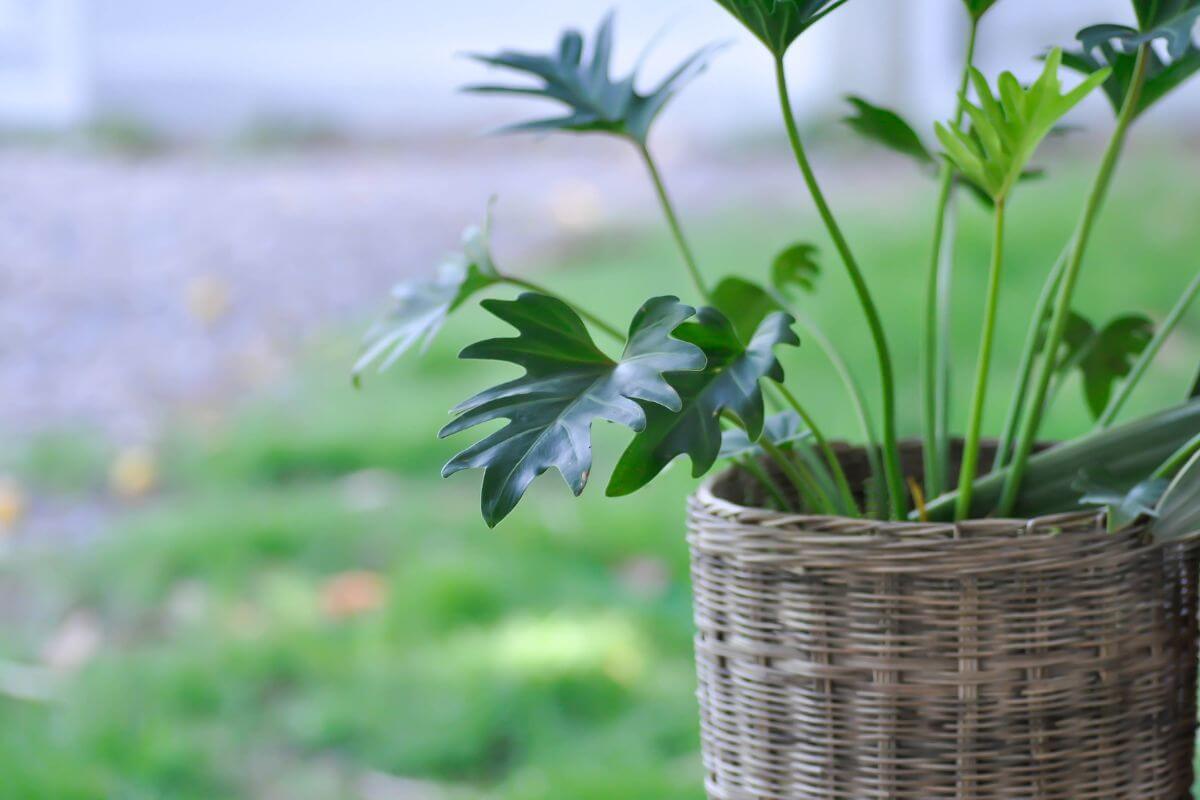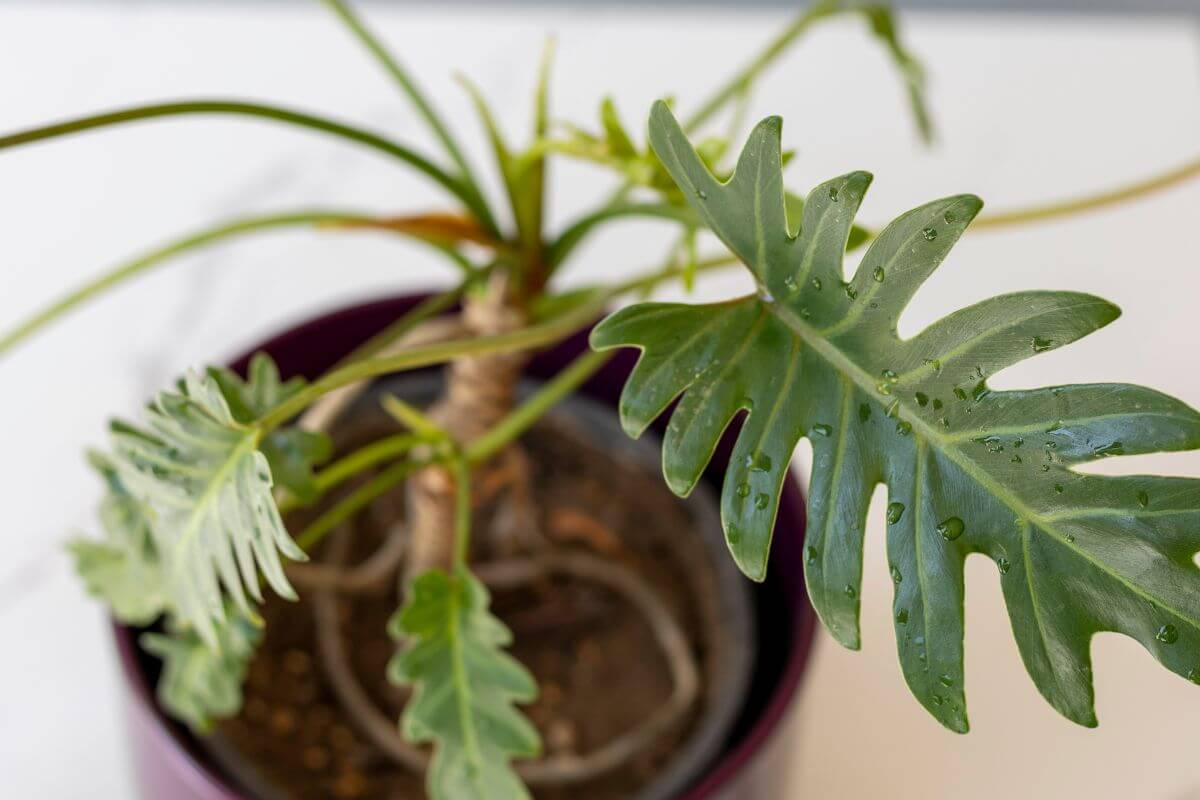Recently renamed the Thaumatophyllum Xanadu in 2018, the Philodendron Xanadu is a beautiful tropical houseplant to include in your home or office. Its upright growth spreads generously, highlighting leaves that are characterized by a deep split.
This guide will cover how to care for your Philodendron Xanadu and help you grow a garden of healthy plants.
- Read more about General Philodendron Care.
Philodendron Xanadu (Thaumatophyllum Xanadu) Overview

A native of Brazil, this original Philodendron variety was given a patent as an Australian cultivar in 1983. Afterward, its true native habitat was discovered through its DNA and leading to the renaming to Thaumatophyllum Xanadu.
Many people today still call it the Philodendron Xanadu since it’s easier to say. In this article, the Philodendron and Thaumatophyllum names are interchangeable as it’s all the same plant.
Wherever you position the Philodendron Xanadu, it will generate a tropical atmosphere, whether indoors as a houseplant or in your outdoor garden. One great thing is that its upright growth is self-supporting, so no stakes, poles, or trellises will be necessary.
The Philodendron Xanadu is characterized by clumps of foliage that can grow to heights of three feet tall and as much as five feet wide. Individual leaves can grow more than a foot-long, even when cultivated in pots.
This particular Philodendron becomes more beautiful with age as its green leaves deepen in color, the trunk thickens, and the aerial roots emerge from the soil bed surface.
The plant features a spathe bloom, but rarely flowers when cultivated indoors in a container.
Philodendron Xanadu Care Guide
Soil for the Philodendron Xanadu
A well-draining soil mix is ideal because it will keep the root system from sitting in waterlogged soil of excess water and guarantee that oxygen arrives. Loose, light soil makes watering easier.
The pH level should measure between 5.6 to 7.5. You can include peat or organic material that will acidify the soil as it degrades. Add perlite and pumice to your soil mix to help aerate it.
In a potting soil mix, consider including these ingredients.
- Compost
- Orchid bark or wood chips
- Peat moss or coconut coir
- Coarse sand
- Pumice
- Perlite
A good Xanadu potting mix recipe is:
- 1/3 compost
- 1/3 peat moss
- 1/3 perlite
Light for the Philodendron Xanadu

The Philodendron Xanadu likes bright indirect sunlight. It cannot be placed directly in the sun as leaves will scorch, discolor or turn pale.
It will thrive near a window or in a bright space as long as sun rays do not shine directly on the plant’s leathery leaves.
Your Xanadu can survive several hours of direct sun exposure, ideally in the early evening or the early morning when the sun is mild.
Fortunately, the Philodendron Xanadu is ideal as a houseplant because it can adapt to low light situations. The foliage may grow darker, but it might also tend to become leggy while searching for light.
Water and Humidity for the Philodendron Xanadu
Probably, the most challenging aspect of cultivating a Xanadu is watering. It needs consistently moist soil, but will not tolerate being waterlogged or sitting in dried-out soil.
Do not plan on watering the Xanadu on a regular schedule, because when your plant needs water, it depends on a number of factors. It’s best to monitor the soil for dryness to know when to water.
When the top inch of the soil bed has dried out, proceed with watering. You can plan on watering approximately once a week. If the soil doesn’t dry quickly, lighten up on how much you water.
The water intake will vary depending on the season and how much bright light it receives. Consistent moisture will be important, especially during the growing season.
Also, consider the size of your container, as excessively large pots filled with soil will take longer to dry out because there are not enough plant roots to absorb the moisture.
More access to bright light will help to dry out wet soil. It’s advisable to flush out the soil bed occasionally to prevent the buildup of salts and toxins.
As a tropical rainforest native, the Xanadu likes humidity, however, it adapts to normal household humidity better than most tropical plants. If there is higher humidity, growth will most likely be lusher.
If your house is heated in the winter or you live in a particularly dry climate, you may want to consider increasing humidity levels. These are common methods to increase humidity levels:
- Use a humidifier around the plants.
- Make a pebble tray by placing a tray filled with stones underneath your Xanadu. The plant’s pot should always sit above the waterline.
- Group several houseplants together. Their natural transpiration will lead to a mutual increase in humidity around the plants. Grouping is not synonymous with crowding, so good airflow circulation is still needed.
Temperature for the Philodendron Xanadu

The Philodendron Xanadu, like other tropical plants, prefers warm temperatures and will do best with a temperature range between 65° and 85°Fahrenheit.
In cold temperatures, your Xanadu will die back. It can recover if temperatures do not drop to freezing.
The Xanadu is also sensitive when temperatures change rapidly, so it should be kept away from drafts that can come from windows and doors, well as heating vents and air conditioners.
The Xanadu can be cultivated outdoors all year in USDA hardiness zones 10 and 11.
Fertilizer for the Philodendron Xanadu
Feeding your Xanadu, especially in the growing season, is important for providing nutrients to your plant. However, the roots of this plant are sensitive, so it’s best to dilute your fertilizer.
You need to feed your plants in the spring and summer, and lightly in the fall. Do not feed during winter in its dormant season.
Use a 20-20-20 balanced fertilizer and dilute it to half of the recommended dosage to avoid overfeeding. Feed your plant every two weeks in the summer, slightly less in the spring and fall, and apply it to a damp soil bed.
Flush out your Xanadu’s soil monthly to prevent salt buildup of fertilizers that may burn the roots. Organic fertilizers are better for sensitive roots. Root burn can cause foliage to discolor and slow growth.
Pruning the Philodendron Xanadu
The Xanadu grows in clumps, so they rarely require pruning. You can trim away dead or dying foliage as you see it.
As the leaves age, they begin to turn yellow and die. They should be removed as soon as you notice them. That will help to prevent pests from taking up residence and to prevent fungus from setting in.
When cutting leaves, always use sterilized scissors or gardening shears to prevent spreading disease. Cut foliage at the base of their stems. If you find the plant becoming too leggy, cut your Xanadu back to encourage new growth.
Repotting the Philodendron Xanadu

When your Xanadu is young, you can repot it once a year. As the plant matures, only repot when necessary.
If you notice the following signs, it’s time to repot.
- If roots are circling the bottom of the pot and your plant is looking rootbound.
- If your plant needs watering every other day or every couple of days.
- Growth is slow or seemingly non-existent.
- The soil bed is no longer draining well.
When it’s time to repot, do so towards the end of winter or the beginning of spring before the emergence of any new leaves.
The Xanadu needs to be snugly potted, so there isn’t a lot of free soil that can become too moist. The container should be no larger than two to three inches bigger than the root ball. Move your plant to its new pot very gently.
Propagating the Philodendron Xanadu
The Philodendron Xanadu can be propagated by using a stem cutting or through root division.
How to Propagate with Stem Cuttings
Propagating the Xanadu with stem cuttings is more difficult. This is so because of the little resistance they have from pathogens that are related to moisture. They are at risk for root rot.
- Cut a six-inch stem cutting from the tip of a younger stem and just above a leaf.
- Remove any lower foliage and leave several leaves at the top of the cutting.
- Place your stem cutting in potting soil or water.
- When choosing to propagate in water, change it often to keep it as fresh as possible.
- If planting directly in the soil, make a hole and place it gently inside. Keep the growing medium moist.
- Give your new plants warmth and bright indirect light. In two to three weeks roots should form.
Philodendron Xanadu Care and Grow Guide Root Division
If you want to use root division as a method, do this while repotting in the early spring. Water your plant thoroughly the day before division to protect the roots.
- After removing the plant from its container, look for a potential separation point between the clumps in the roots.
- When dividing, make sure that there is more than one stem in each clump.
- Separate the root ball into the number of sections you want for your new plants. Pull gently when separating. If roots are entwined, trim them with sterile shears. If the shears are not sterile, you risk the spread of plant diseases among your indoor plants.
- Repot the single sections in individual containers. The new plants should be put in new pots at the same depth as the original plant. Cover the white part of the Xanadu stems.
- Water your new plants gently, while they are adjusting to their new home.
Philodendron Xanadu Toxicity and Pets
The Philodendron Xanadu is toxic to pets and humans because of the calcium oxalate crystals in its sap.
Calcium oxalate crystals may not be fatal in small amounts, but can lead to swelling, burning, and breathing difficulties. The sap can irritate the skin. If a large quantity is ingested, it can cause kidney failure.
Poison symptoms to watch for include:
- Lack of appetite
- Swollen mouth, tongue, or lips
- Mouth sores
- Pawing at the face
- Problems Swallowing
- Vomiting
- Excessive Drooling
If your pet has chewed the Philodendron leaves, rinse its mouth right away. Do the same for skin irritation. If swelling occurs, call your vet. In the event of severe symptoms, get your pet to emergency care.
Philodendron Xanadu Pests, Diseases, and Problems

The Xanadu is not overly susceptible to pests. But occasionally you may find scale insects or mealybugs. You can remove these pests manually and then clean your plant with a cotton ball and alcohol. Apply insecticidal soap or organic neem oil.
Philodendron Xanadu Diseases
The Philodendron Xanadu also does not particularly suffer from fungal diseases. The only exception may be the bacterial infection of Erwinia. It spreads quickly, will liquefy leaves, and produce an unseemly odor.
With Erwinia, quarantine your infected plant and keep it far away from other houseplants. Remove all affected leaves, stems, and other parts. Dispose of them securely.
Sterilize tools to not promote further contamination and spread. Wash your hands or gardening gloves as well. Ascertain that there is sufficient air circulation.
Philodendron Xanadu Final Thoughts
The Thaumatophyllum Xanadu is a stunning plant to place in any location and features a unique sculptural quality to their leaves. It’s superb with its stunning dark green and deeply split foliage. So, if you have the space, this is one impressive plant to possess.
For other Philodendron species plant care guides, check out these articles:
- Philodendron Lemon Lime Care Guide
- Philodendron Pink Princess Care Guide
- Philodendron McDowell Care Guide
- Philodendron Paraiso Verde Care Guide
- Philodendron Hope Selloum Care Guide
- Christia Obcordata Care Guide
Philodendron Xanadu FAQs
Does Philodendron Xanadu like full sun?
The Philodendron Xanadu prefer bright indirect light, but they can tolerate full sun and low-light conditions for short periods of time. As a tropical plant, in their native habitats, they live in partial shade.
Is Philodendron Xanadu an indoor plant?
The Philodendron Xanadu can be an indoor or outdoor plant. As tropical plants, they prefer warm temperatures that an indoor environment usually gives them. They are commonly used as houseplants because they are very hardy and easy to grow. They are also known for their large size, making them perfect for indoor spaces.
Is Philodendron Xanadu a climber?
No, the Philodendron Xanadu is not a climber or vine, it’s an upright plant. As the Xanadu gets older, it will become bushier, develop a short trunk, and grow aerial roots.
How do you make Philodendron Xanadu bushy?
The Philodendron Xanadu is already a bushy growing plant and doesn’t need much help getting bushy. Increasing the humidity levels around the Xanadu will help encourage the foliage to grow more lush as well. Adding a humidifier and misting the leaves will both help make the Xanadu bushier.
What goes well with Philodendron Xanadu?
Companion plants that go well with the Philodendron Xanadu include dracaena, philodendrons, spiderworts, peace lilies, and bromeliads. These plants work together to create a harmonious environment for each other.
Is Philodendron Xanadu an air purifier?
Yes, the Philodendron Xanadu is a good air purifying plant. It has large leaves that help to remove airborne pollutants such as pollen, dust, and smoke. This makes the plant ideal for allergy sufferers and people who want to reduce allergens in their home.


